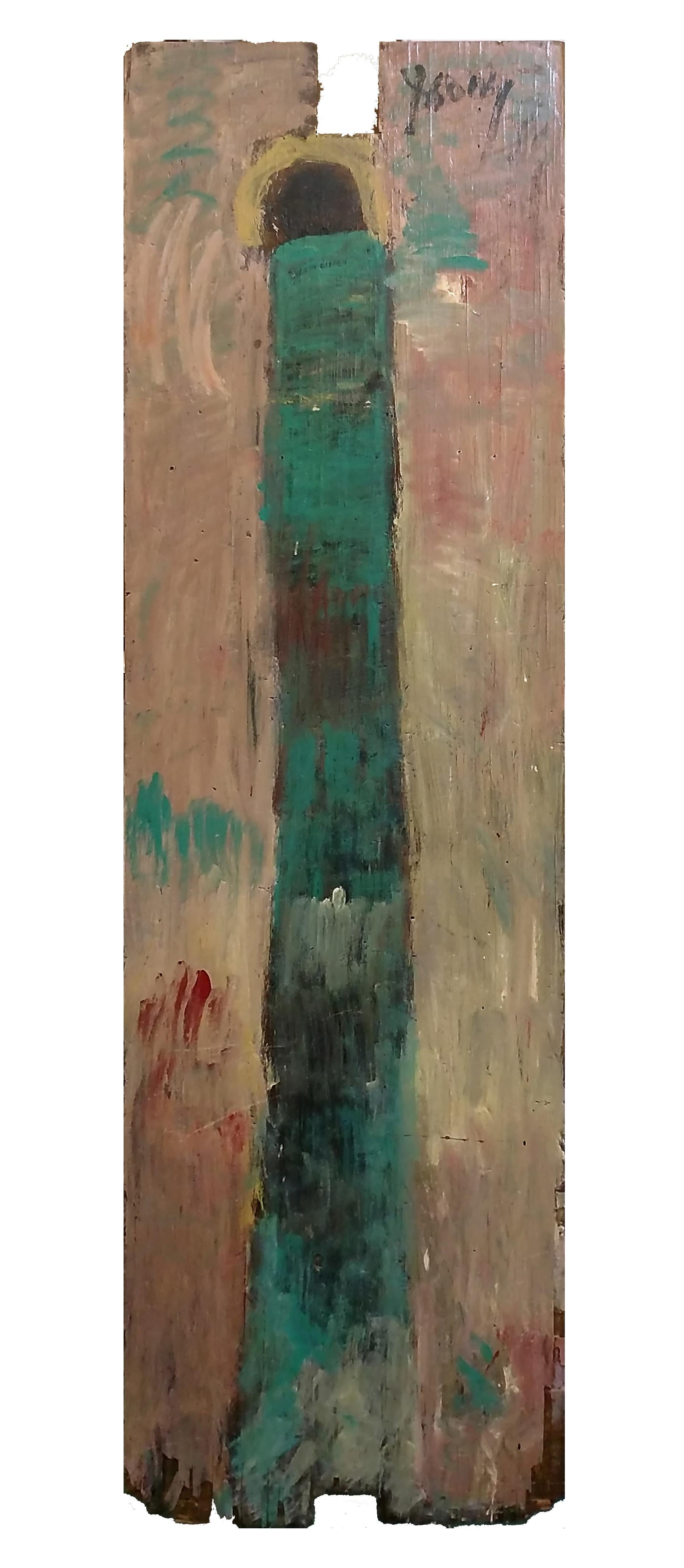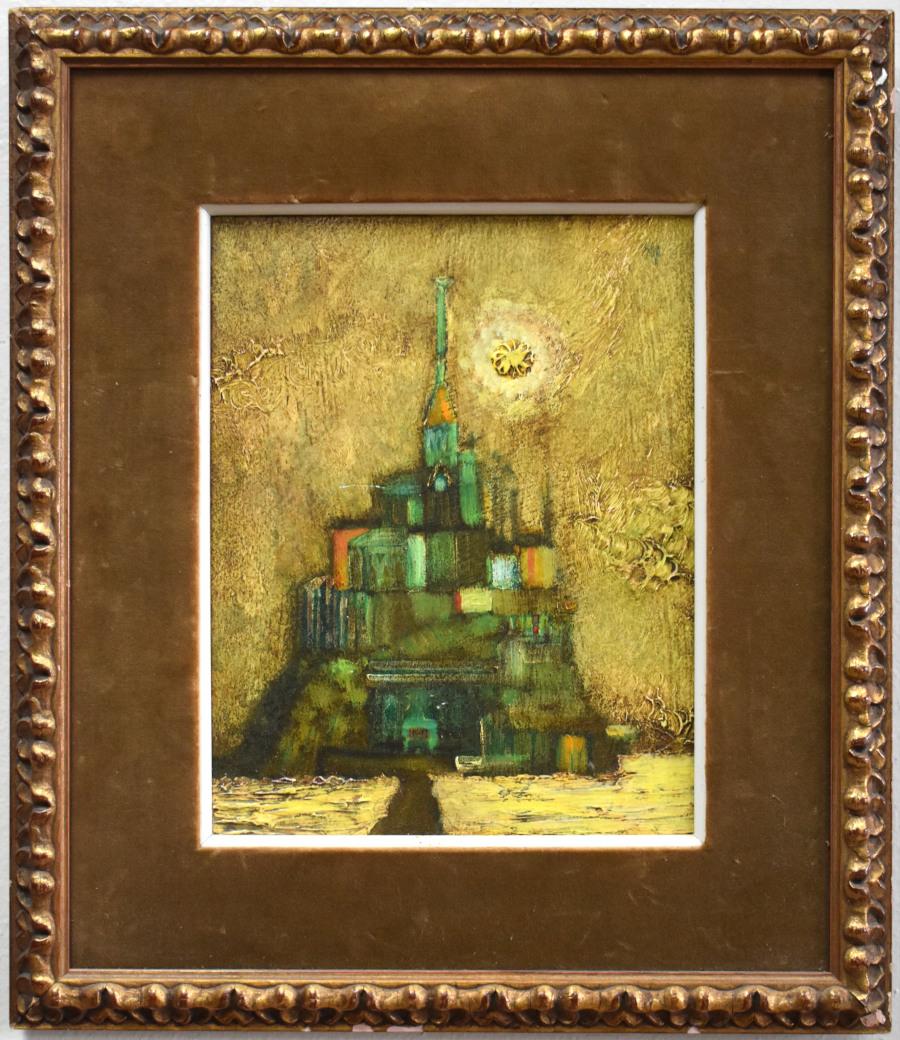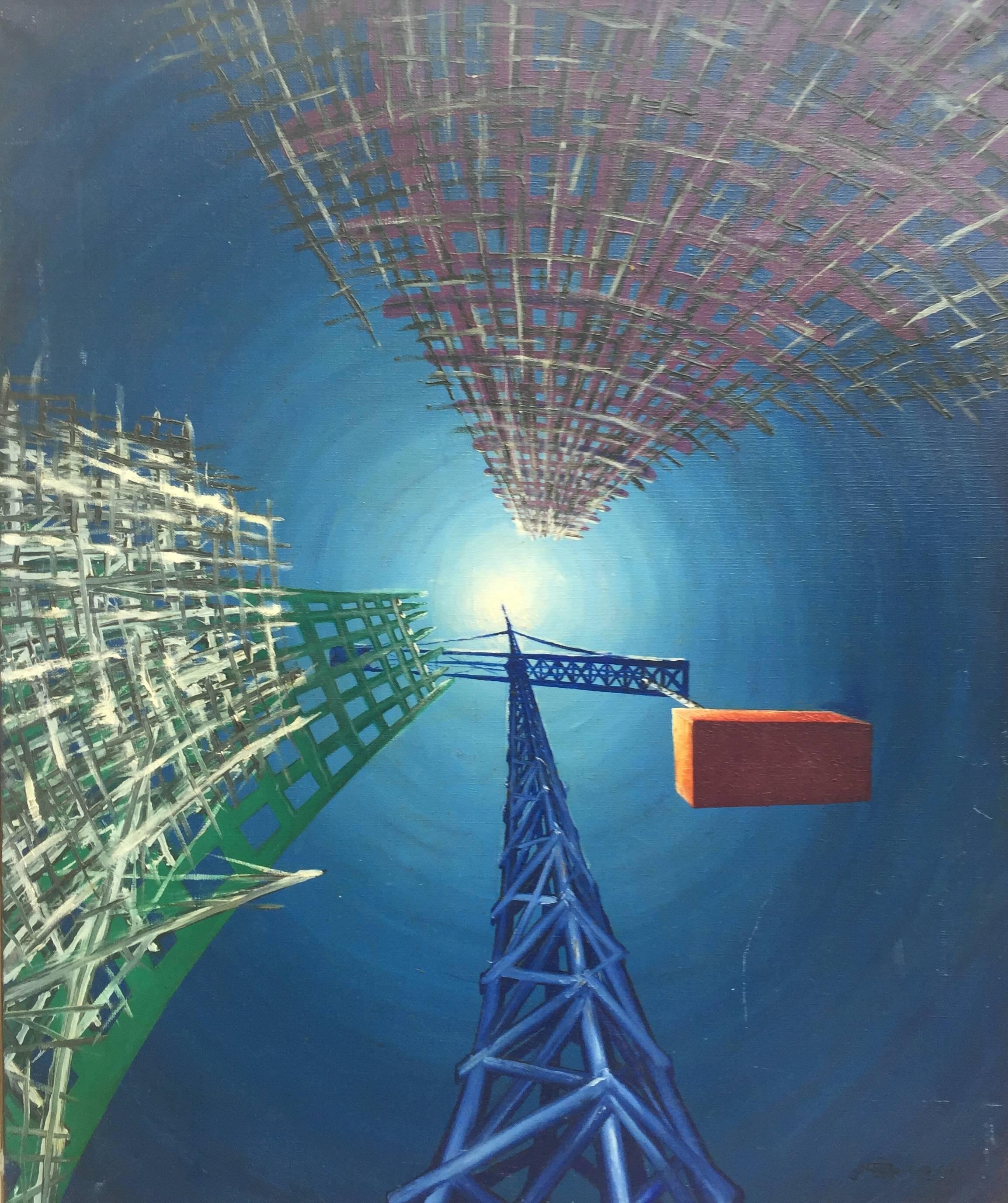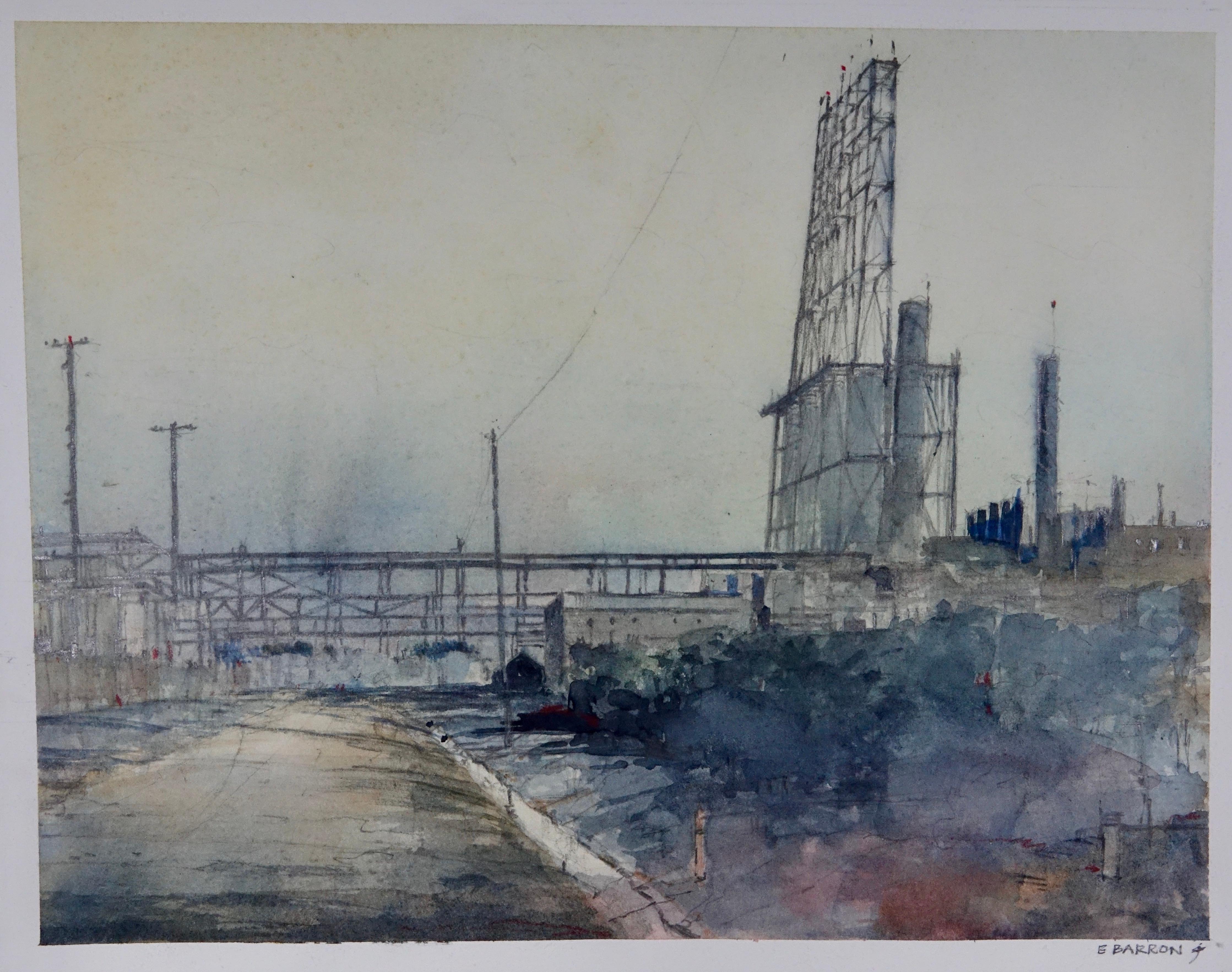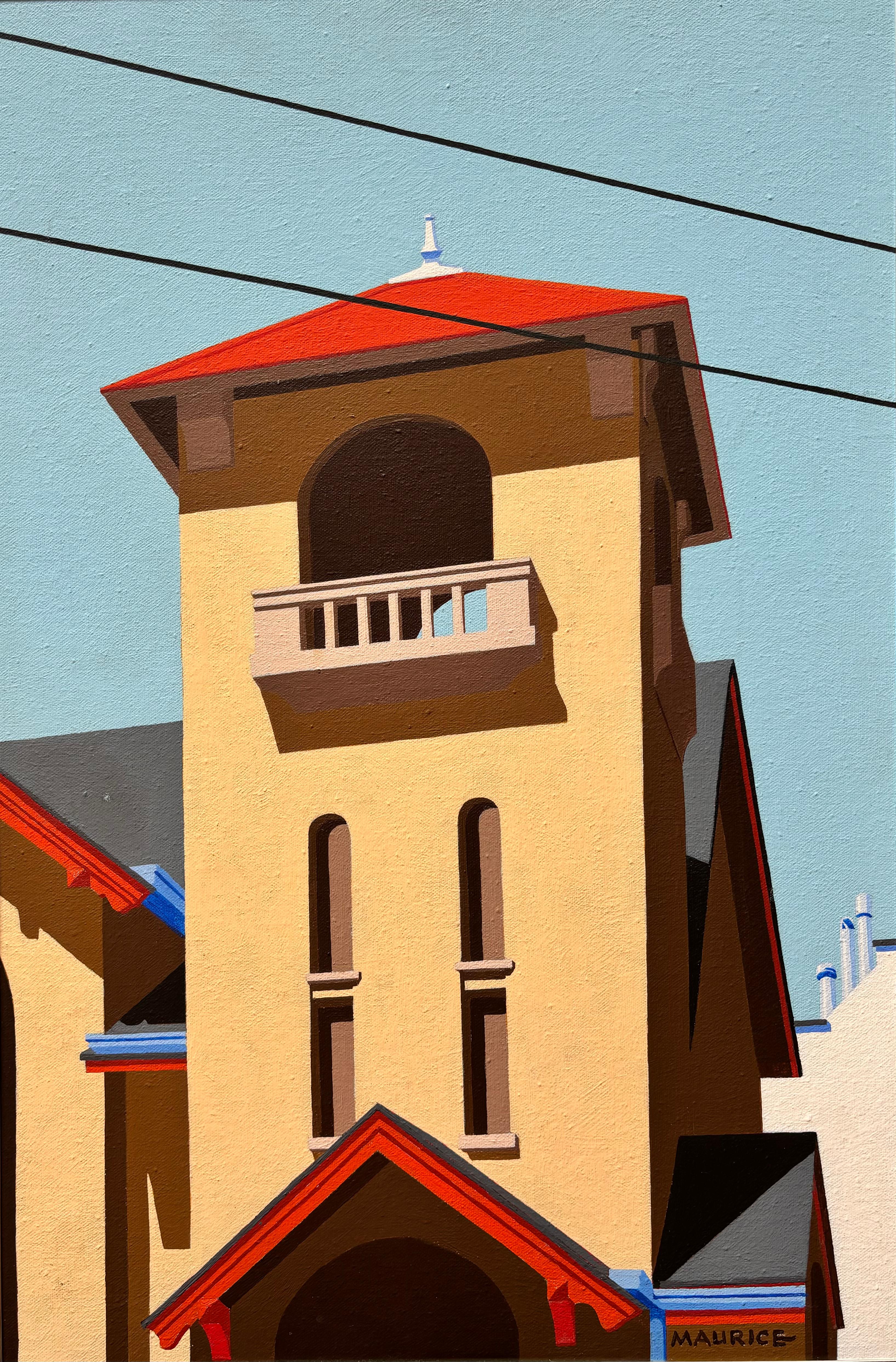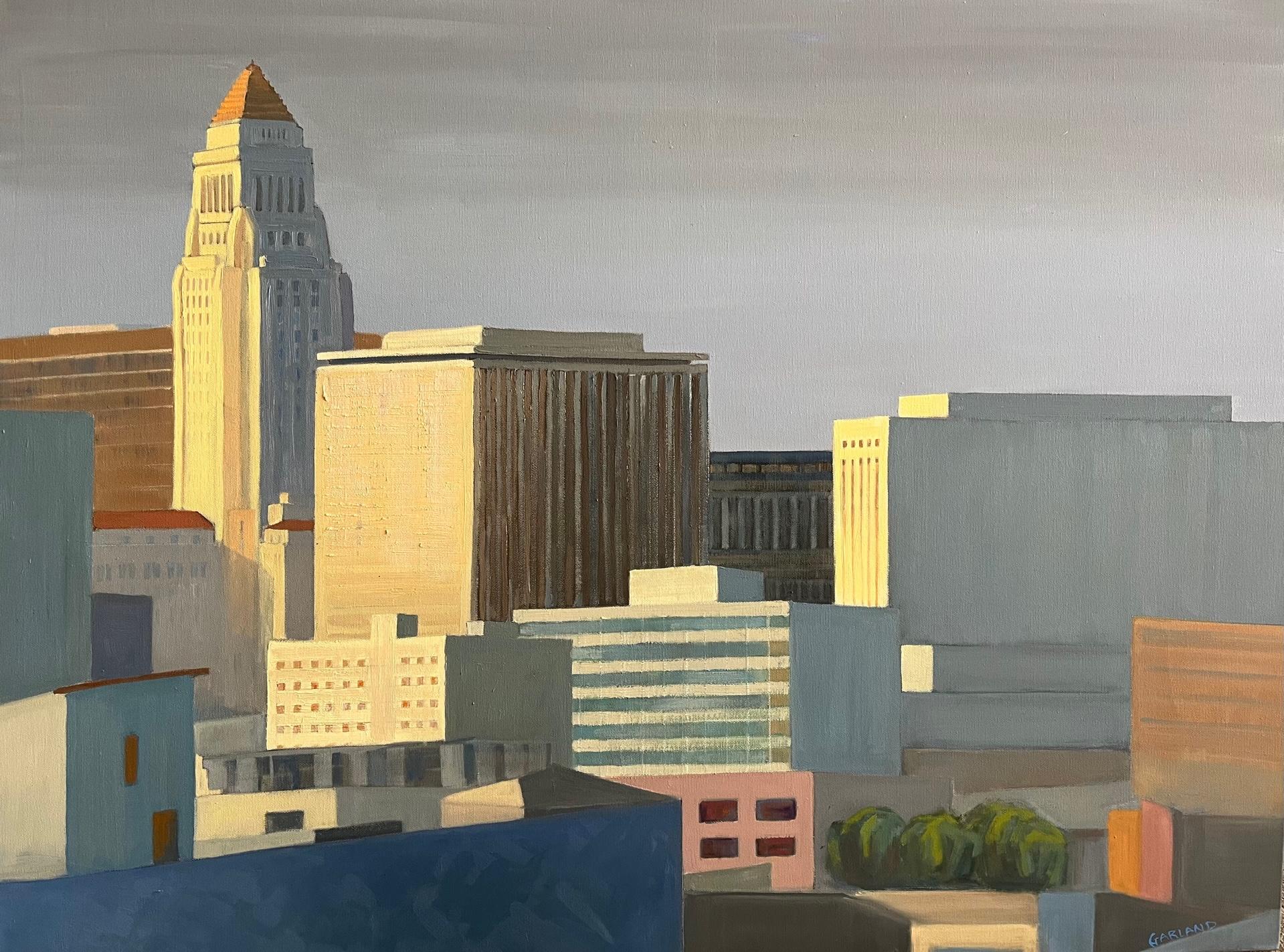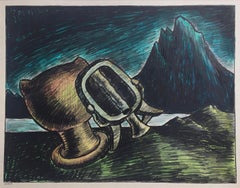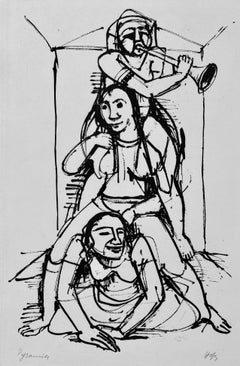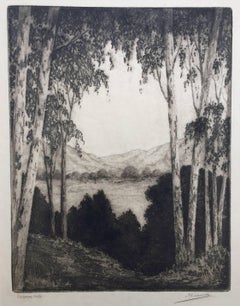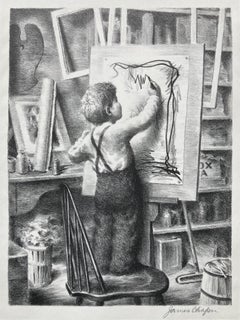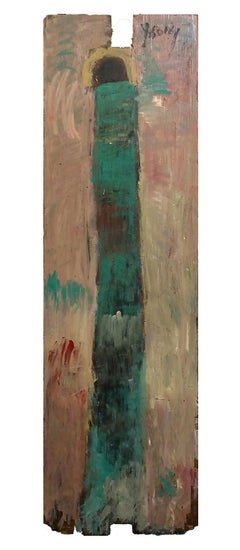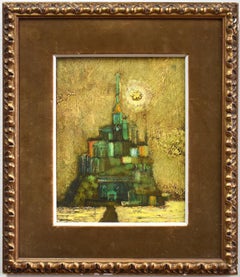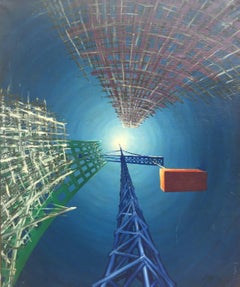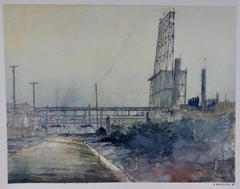Want more images or videos?
Request additional images or videos from the seller
1 of 15
Gloria StuartWATTS TOWER1971
1971
$12,000
£9,270.76
€10,537.61
CA$17,062.30
A$18,571.56
CHF 9,782.59
MX$226,063.58
NOK 122,500.82
SEK 115,006.20
DKK 78,695.38
About the Item
GLORIA STUART (1910 – 2010)
WATTS TOWERS, 1971
Oil on canvas, signed lower right, 24” x 50 ½”. Gloria Stuart, an Academy Award nominated actress was also a painter, illustrator and printmaker. She most recently portrayed Rose in the blockbuster film “Titanic”. She was a Santa Monica native.
In 2013 The Los Angeles Museum of Art, LACMA exhibited a nearly identical painting looking from the south, the same size and frame. Last 5 photos show the example at LACMA. One shows theirs in a distant room with a major Thomas Hart Benton painting in the foreground
A VERY IMPORTANT MULTI-LEVELED DOCUMENT OF LOS ANGELES AND HOLLYWOOD CULTURAL HSTORYi
The following is from her obituary in the Los Angeles Times upon her death in September 2010 at the age of 100
Gloria Stuart, a 1930s Hollywood leading lady who earned an Academy Award nomination for her first significant role in nearly 60 years — as Old Rose, the centenarian survivor of the Titanic in James Cameron’s 1997 Oscar-winning film — has died. She was 100.
.......She devoted much of her time to designing and printing artists’ books (handmade, letter-press printed books in limited editions, with her own artwork and writing). Her work is in the J. Paul Getty Museum in Los Angeles, the Metropolitan Museum of Art in New York City, the Victoria and Albert Museum in London and other museums.
Stuart, a founding member of the Screen Actors Guild who later became an accomplished painter and fine printer, died Sunday night at her West Los Angeles home, said her daughter, writer Sylvia Thompson.
Stuart had been diagnosed with lung cancer five years ago.
“She also was a breast cancer survivor,” Thompson said, “but she just paid no attention to illness. She was a very strong woman and had other fish to fry.”
In July the actress was honored at an “Academy Centennial Celebration With Gloria Stuart” at the Samuel Goldwyn Theater in Beverly Hills.
“She was a charming and beautiful leading lady in the ‘30s, and I never understood why her career didn’t go further at that time,” film historian and critic Leonard Maltin, who interviewed Stuart on stage at the event, told The Times on Monday.
As for Stuart’s high-profile comeback in “Titanic”: “She was thrilled by the attention that that performance brought her and really wanted to win that Oscar. I thought she hit just the right notes in that performance. She was wry and engaging.”
As a glamorous blond actress under contract to Universal Studios and 20th Century Fox in the 1930s, Stuart appeared opposite Claude Rains in James Whale’s “The Invisible Man” and with Warner Baxter in John Ford’s “The Prisoner of Shark Island.”
She also appeared with Eddie Cantor in “Roman Scandals,” with Dick Powell in Busby Berkeley’s “Gold Diggers of 1935” and with James Cagney in “Here Comes the Navy.” And she played romantic leads in two Shirley Temple movies, “Poor Little Rich Girl” and “Rebecca of Sunnybrook Farm.”
But mostly she played what Stuart later dismissed as “stupid parts with nothing to do” — “girl reporter, girl detective, girl nurse” — and “it became increasingly evident to me I wasn’t going to get to be a big star like Katharine Hepburn and Loretta Young.”
After making 42 feature films between 1932 and 1939, Stuart’s latest studio contract, with 20th Century Fox, was not renewed. She appeared in only four films in the 1940s and retired from the screen in 1946.
By 1974, “the blond lovely of the talkies” had become an entry in one of Richard Lamparski’s “Whatever Happened to” books.
Writer-director Cameron’s $200-million “Titanic” changed that.
Stuart played Rose Calvert, the 100-year-old Titanic survivor who shows up after modern-day treasure hunters searching through the wreckage of the sunken ship find a charcoal drawing of her wearing a priceless blue diamond necklace.
Stuart’s performance as Old Rose frames the 1997 romantic- drama that starred Leonardo DiCaprio as lower-class artist Jack Dawson and Kate Winslet as the upper-class young Rose.
In “Gloria Stuart: I Just Kept Hoping,” her 1999 autobiography, Stuart said that after reading the script, “I knew the role I had wanted and waited for all these many years had arrived! I could taste the role of Old Rose!”
Cameron told The Times in a 1997 interview that he chose Stuart because he was “looking for a pro from the ‘30s or ‘40s, someone probably retired, maybe off the Hollywood radar for awhile.”
“I had to have someone who’d play the latter part of the life of someone we’d recognize, Kate Winslet, so it couldn’t be someone like Katharine Hepburn. We know so well what she looked like [when she was young],” Cameron said. “Gloria had just enough distance, and she gave this fantastic reading.”
At 87, Stuart became the oldest actress ever nominated for an Academy Award.
In addition to Oscar and Golden Globe nominations, she won a Screen Actors Guild award for outstanding performance by a female actor in a supporting role (tying with eventual Oscar-winner Kim Basinger for “L.A. Confidential”).
In the multiple-Oscar-winning blockbuster’s wake, Stuart found herself swamped with fan mail and interview requests. She also was faced with being recognized in the supermarket and finding her old films resurfacing on television. People magazine even named her one of the 50 most beautiful people in the world.
In 2000, several hundred fans gathered on Hollywood Boulevard next to the Egyptian Theater for the unveiling of Stuart’s star on the Hollywood Walk of Fame.
“I cannot begin to tell you how rewarding and nourishing and warming it is,” she said at the ceremony. “I wake up every day and say, ‘What a wonderful life. How lucky I am.’ ”
A third-generation Californian, she was born Gloria Stewart in Santa Monica on the Fourth of July, 1910. She later changed the spelling of her last name to Stuart, reasoning that the six letters would balance perfectly on a theater marquee with the six letters in “Gloria.”
In high school, she took classes in short-story and poetry-writing and worked for free as a “girl reporter” at the Santa Monica Outlook.
While attending UC Berkeley, where she acted in a campus theatrical group, Stuart met a handsome young sculptor, Gordon Newell. They were married in 1930 and moved to Carmel, where she worked on the local newspaper and appeared in little theater productions.
In 1932, after playing Masha in a little theater production of Chekhov’s “The Seagull” in Carmel, the visiting director asked her to play the role again in a small theater in the Los Angeles area.
Casting directors from both Paramount and Universal saw her performance and offered her screen tests. She wound up signing a seven-year contract with Universal: $125 a week to start, with singing and acting lessons included.
Stuart’s union activities began while making Whale’s 1932 horror comedy “The Old Dark House” with Boris Karloff and Melvyn Douglas.
“All of us were just exhausted by the long hours, and Melvyn Douglas leaned over to me in this theatrical way,” she recalled in a 1998 Los Angeles Times interview. “He whispered the word ‘union’ in my ear. And I thought, ‘Yes!’ ”
At the time, she wrote in her autobiography, “Actors worked unconscionable hours — especially females, because every morning our needs included a great deal of time in hairdressing and makeup. Meals were served at the convenience of the production staff. There was no allotment for travel time, no standard hours between work calls, no pay for overtime or double overtime — what we call golden time. And if an actor under contract refused a role the studio had chosen, he/she was suspended without pay — and the time was added on to the contract!”
Despite stiff studio resistance, the Screen Actors Guild was founded in 1933.
Discovering that she “took to politics like a duck to water,” Stuart helped form the Hollywood Anti-Nazi League in 1936, the same year she and writer Dorothy Parker helped organize the League to Support the Spanish War Orphans. She also became a member of the Hollywood Democratic Committee and was on the executive board of the California State Democratic Committee.
Stuart’s fledgling movie career took a toll on her marriage to Newell and they divorced. In 1934, she married screenwriter Arthur Sheekman, with whom she had her daughter Sylvia.
Stuart, whose career at Universal failed to take off, signed with 20th Century Fox in 1935.
After Fox declined to renew her contract in 1939, she acted in summer theater on the East Coast and made a failed attempt at Broadway before returning to Hollywood and turning her creative energies into the art of decoupage. She opened a shop on La Cienega Boulevard called Décor Ltd., which lasted more than four years.
In 1954, inspired by an exhibition of Impressionist paintings in Paris, she began painting. Her first one-woman show, at the Hammer Galleries in New York in 1961, was a critical hit. Art News called her “a deft primitive with a beguiling variety of subjects.” She went on to have exhibits in major galleries.
In 1975, four years after her husband was stricken with Alzheimer’s disease, Stuart decided to return to acting. From 1975 to 1988, she had about a dozen minor roles on TV and in movies, including dancing with Peter O’Toole in a nightclub scene in the 1982 film “My Favorite Year.”
As her husband became ill, Stuart began taking classes in bonsai. She became an honored member of local bonsai clubs, and her trees are in the bonsai collection at the Huntington Library, Art Collections and Botanical Gardens in San Marino.
Five years after Sheekman’s death in 1978, Stuart renewed a friendship with an old friend from her college years: Ward Ritchie, who had become a world-renowned master printer. The friendship quickly grew into an autumn romance. From Ritchie, Stuart developed an interest in fine letter-press printing and bought her own hand press.
She devoted much of her time to designing and printing artists’ books (handmade, letter-press printed books in limited editions, with her own artwork and writing). Her work is in the J. Paul Getty Museum in Los Angeles, the Metropolitan Museum of Art in New York City, the Victoria and Albert Museum in London and other museums.
About four months after Ritchie’s death in 1996 at 91, Stuart received a call from James Cameron’s casting director, Mali Finn.
“The next day, Jim came with a video camera,” Stuart told The Times in 1997. “I read for him for about an hour, then I didn’t hear anything, so I wrote him a letter and said, ‘I’ve re-read the script and I should’ve given it a feistier reading.’ I mailed it on Friday and Monday Mali Finn called and said, ‘How would you like to be Old Rose?’ I screamed and hollered.”
Besides her daughter, Stuart is survived by four grandchildren and 12 great-grandchildren.
A private funeral service will be held.
- Creator:Gloria Stuart (1910-2010, American)
- Creation Year:1971
- Dimensions:Height: 24 in (60.96 cm)Width: 45 in (114.3 cm)
- Medium:
- Movement & Style:
- Period:
- Condition:
- Gallery Location:Santa Monica, CA
- Reference Number:1stDibs: LU411312217662
About the Seller
5.0
Recognized Seller
These prestigious sellers are industry leaders and represent the highest echelon for item quality and design.
Gold Seller
Premium sellers maintaining a 4.3+ rating and 24-hour response times
Established in 1977
1stDibs seller since 2016
296 sales on 1stDibs
Typical response time: 1 hour
Associations
International Fine Print Dealers Association
- ShippingRetrieving quote...Shipping from: Santa Monica, CA
- Return Policy
Authenticity Guarantee
In the unlikely event there’s an issue with an item’s authenticity, contact us within 1 year for a full refund. DetailsMoney-Back Guarantee
If your item is not as described, is damaged in transit, or does not arrive, contact us within 7 days for a full refund. Details24-Hour Cancellation
You have a 24-hour grace period in which to reconsider your purchase, with no questions asked.Vetted Professional Sellers
Our world-class sellers must adhere to strict standards for service and quality, maintaining the integrity of our listings.Price-Match Guarantee
If you find that a seller listed the same item for a lower price elsewhere, we’ll match it.Trusted Global Delivery
Our best-in-class carrier network provides specialized shipping options worldwide, including custom delivery.More From This Seller
View AllSURREALIST LANDSCAPE
By Edward Hagedorn
Located in Santa Monica, CA
EDWARD HAGEDORN (AMERICAN 1902 – 1982)
SURREAL LANDSCAPE 1931 mixed media on paper, Graphite, ink and watercolor. Unsigned. Dtaed 2/26/31, in ink lower left margin. Image 13 3/4 x 16 1/2 inches. On a large sheet 20 x 25 inches.
Provenance: Hagedorn estate, Around the mid 1980's The Hagedorn estate was dispersed in Berkeley by a local dealer. This drawing was part of a group of Hagedorn works on paper that I acquired from that dispersal. Much of the balance was later acquired the Struart Denenberg Fine Art.
Denenberg published a very fine book on the artist's work.
EDWARD HAGEDORN: CALIFORNIA MODERNIST, RESTLESSNESS AND RESTRAINT Hardcover – January 1, 2009
Subsequently Hagedorn's works on paper have been acquired by many museums and some accompanying exhibitions.
ALL OF THE COMMENTS BELOW ARE FROM THE FOLLOWING EXHIBITION
EDWARD HAGEDORN (1902-1982)
American Modernist
A New Traveling Exhibition
“VOLCANOS, WRECKS, RIOTS, & NUDES”, EDWARD HAGEDORN (1902-1982)
premiere at the Danforth Museum. Framingham, MA, in March 2016. The exhibition includes 75 works of art in various mediums and is accompanied by the first monograph devoted to the artist’s work with essays by leading curators, critics, and art historians.
Edward Hagedorn was a true Modernist who created a trove of powerful works on paper--drawings, watercolors, oils, and original graphics that reveal the hand of a master draftsman and the mind of an astute political observer. He rejected the general trend in early 20th century California of local landscapes and coastal views, becoming virtually the single voice of Expressionism. He conveyed the darkness and upheaval that gripped the country in the depression years between the two World Wars, 1925- 1935, more forcefully than any of his contemporaries, influenced by German art of the time, engaging in modernist styles of Expressionism and Surrealism.
Hagedorn’s skeletons are ferocious yet somehow endearing; printed in deep black ink on off-white paper, they march across Lilliputian landscapes of grim disorder and destruction. Comets and volcanoes explode in fauvist colors, their other-worldly fluorescent temperas framed in black, while nude female figures, executed in exquisitely refined pen and ink, or graphite line drawings, are as economical in their means as Matisse, and can be compared with the neo-classical drawings of Picasso. Among his most lyrical works of the 1920s is a series of rhythmically abstracted watercolor and ink views of Golden Gate Park, evoking the sensual demi-geometries of Balthus, Derain , and early Mondrian.
American Modernist Edward Hagedorn (1902-1982) was born in San Francisco of German descent; his mother (née Kafka) died in childbirth, and he was legally adopted and raised by his grandmother and aunt. After attendance at the San Francisco School of Fine Arts in the early 1920s, by age 22 he had a studio in the famed "100" block of Montgomery Street ("the Monkey Block,") then a haven for bohemians.
In 1926, a year of tremendous importance in California artists' embrace of modern art, the Oakland Art Gallery, with the guidance and inspiration of their European representative Emmy (Galka) Scheyer, was the first museum in the United States to show the art of the "Blue Four," among the leading artists of International Modernism--Paul Klee, Lyonel Feininger, Alexei Jawlensky...
Category
1930s American Modern Mixed Media
Materials
Watercolor
$3,000 Sale Price
33% Off
PYRAMID
Located in Santa Monica, CA
KARL HOFER / Carl Hofer (German 1878-1955)
PYRAMID, 1924
Lithograph, signed and titled in pencil. Unknown edition but small. Image 15 1/2 x 10, sheet 18 1/...
Category
1920s Modern Figurative Prints
Materials
Lithograph
CALIFORNIA VISTA
By Harold Lukens Doolittle
Located in Santa Monica, CA
HAROLD L. DOOLITTLE (1883 – 1974)
CALIFORNIA VISTA, 1923
Aquatint signed and titled in pencil. 8 7/8 x 6 7/8 inches. Sheet 11 x 14 inches. Good condi...
Category
1920s American Realist Figurative Prints
Materials
Aquatint
$780 Sale Price
20% Off
COMPOSITION - Lovely design portraying a future Abstract Expressionist.
Located in Santa Monica, CA
JAMES CHAPIN (1887 – 1975)
COMPOSITION c. 1940
Lithograph signed in pencil, Image 11 7/8 x 7 ¾ inches, sheet 13 5/8 x 10 5/8 inches. Just a hint of mat line in the margins and on the verso. Some remnants of old tape prImarily at the left & right sheet edges. Rather scarce print but possibly published by Associated American Artists.
WONDERFUL PORTRAYAL OF AN UP AND COMING ARTIST...
Category
1940s American Modern Figurative Prints
Materials
Lithograph
MANHATTAN
By Anton Schutz
Located in Santa Monica, CA
ANTON SCHUTZ
MANHATTAN c 1940
Etching, signed in pencil, edition 100, no. 15/100. On thin simili-japan paper. Very slight toning around plate mark. Remnants of old tape on verso, s...
Category
1940s American Realist Landscape Prints
Materials
Etching
Columbus Circle
By Arnold Rönnebeck
Located in Santa Monica, CA
ARNOLD RONNEBECK (1885 – 1947)
COLUMBUS CIRCLE ca. 1929
Lithograph, edition probably 50. Signed and titled in pencil, 12 ½” x 8 ¼” In very good condit...
Category
1920s American Modern More Prints
Materials
Lithograph
Price Upon Request
You May Also Like
THE TOWER (PAINTING ON WOOD)
By Purvis Young
Located in Aventura, FL
Hand signed on front by the artist. Original mixed media painting on wood.
The artwork is in excellent condition and comes with a Certificate of Aut...
Category
Late 20th Century Outsider Art Mixed Media
Materials
Wood, Mixed Media
$8,750 Sale Price
30% Off
"ABSTRACT CHURCH TOWER"
By Lamar Briggs
Located in San Antonio, TX
Lamar Briggs
(1935-2015)
Houston Artist
Image Size: 14 x 11
Frame Size: 22.75 x 19.75
Medium: Oil
"Church Tower"
Lamar Briggs (1935-2015)
Following is an obituary of the artist, publ...
Category
Mid-20th Century Impressionist Landscape Paintings
Materials
Oil
"Skyscraper's"
By Georges Noel
Located in Southampton, NY
Georges Noel (1924 - 2010) Size: 28.5 x 23.5 inches. Oil/Canvas.Painting with Paris 'Salon Des Independants 1970' Exhibition label verso. In 1955, his art...
Category
1960s Modern Landscape Paintings
Materials
Oil
$2,560 Sale Price
20% Off
Norco Gateway
By Errol Barron
Located in New Orleans, LA
Framed sized is 16 x 20 inches. Framed in a white oak frame.
In any landscape there are places and objects of quiet monumentality so ingrained into the scene that they are nearly invisible or regarded only as ordinary or outdated artifacts of the past. Some are small in scale, and some suggest a kind of architectural grandeur mixed with a pathos stemming from their obsolete utility and the evidence they bear of the passage of time. Some, like the abandoned oil rigs in and around the Gulf of Mexico, are poignant reminders of environmental optimism and tragedy.
Primarily encountered on trips around our region, stretching up as far as the delta of northwestern Mississippi and southeastern Arkansas and as far south as the mouth of the Mississippi, these places and objects evoked the curiosity and affection, which prompted this show. The paintings, the result of a labor-intensive technique requiring many layers of color, are intimately sized though they often deal with subjects of great scale.
Trained as an architect and a practicing architect until 2016, Barron now works primarily as a painter. For many years he has taught at the Tulane University School of Architecture and is a Fellow in the American Institute of Architects. In 2012, he was awarded the Gold Medal of the Louisiana Architects Association and in 1995 was awarded the prestigious Gabriel Prize from the Western European Architecture Foundation.
Errol Barron...
Category
2010s Realist Landscape Paintings
Materials
Paper, Mixed Media, Watercolor
Tower and Wires
Located in Los Angeles, CA
Tower and Wires, 1987, acrylic on canvas, signed lower right, 24 x 16 inches, exhibited: Alfred P. Maurice Artist in the City Paintings 1979 - 1997, Archer Gallery of Clark College, ...
Category
1980s American Modern Landscape Paintings
Materials
Canvas, Acrylic
City of Angels Hall
By Carole Garland
Located in Palm Desert, CA
The artist Carole Garland, from Chicago, remembers her move to Los Angeles and her wonder at "Where are all the tall buildings? and Why so much blue sky?" She came to love the City o...
Category
21st Century and Contemporary Contemporary Landscape Paintings
Materials
Oil, Wood Panel
$2,400 Sale Price
20% Off
